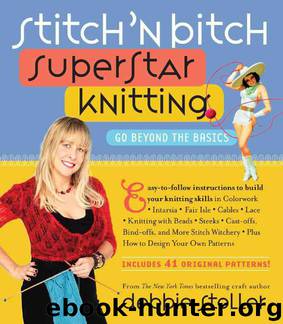Stitch 'n Bitch Superstar Knitting: Go Beyond the Basics by Stoller Debbie

Author:Stoller, Debbie [Stoller, Debbie]
Language: eng
Format: epub
Publisher: Workman Publishing Company
Published: 2012-10-31T22:00:00+00:00
SLEEVES AND ARMHOLE DEPTH
We take the wrist measurement from a person’s body (see page 123). For this example, we’ll use 7.5" and write that in. Now we need to take two additional body measurements for the raglan sweater, which we didn’t need for the drop-shoulder sweater: the sleeve length from underarm to wrist and the upper-arm circumference.
The length of the lower section of the sleeve—from wrist to underarm—should be equal to the sleeve length measured from the underarm to the wrist, minus an inch to give the armpit room to breathe. Let’s say we measured the arm from armpit to wrist to be 19"; subtracting an inch from that, we get 18". Write that in. Now for the width at the upper arm. For our example, we measured this to be 13". To add ease to the upper arm circumference, the standard is to add 50–100% of the body ease. Let’s start by adding just 50% (we may end up adjusting this later).
Our body ease is 2", and 50% of that is 1". So our total sleeve width at the upper arm is 13" + 1" ease = 14". Let’s write that in. After binding off 1" at each side, we end up with 12" just above the upper arm. Let’s write this in, too.
Okay, now for the somewhat tougher part, where we may need to jiggle up our numbers a bit.
First of all, I want the sleeve at the very top to be only 1–1½" wide—that’s a standard for this type of sweater. I know that I need to decrease the front and back of the sweater from 18" wide at the armhole to 7" wide at the back of the neck. And I know that this means I have to decrease 11" worth of stitches. I’m going to pull out some stitch counts here for just a minute to prove a point. Multiplying 11" by my stitch gauge of 5 gives me 55 stitches that I’ll need to decrease, which I’ll round up to 56 so I can decrease them 2 stitches at a time. And dividing this number in half means that I’ll have to evenly space 28 decrease rows over some, as yet unknown, total number of rows.
I promised you that the decreases for the sleeve cap and the front/back decreases were exactly the same, right? That means if I’m making 28 decrease rows on the front, then I also need to make 28 decrease rows on the sleeve cap, and they need to be spaced apart in the same way. And if I’m making 28 decrease rows for the sleeve cap, that means I’m decreasing 56 stitches on the sleeve cap (remember, we always decrease two stitches on a decrease row—one on each side). And if I’m decreasing 56 stitches on the sleeve, that means I’m decreasing 11" (56 divided by 5) from the sleeve after the armhole bind-off. Do you recognize that 11"? It’s the same width we decreased on the body to get to the neck width.
Download
This site does not store any files on its server. We only index and link to content provided by other sites. Please contact the content providers to delete copyright contents if any and email us, we'll remove relevant links or contents immediately.
On Writing A Memoir of the Craft by Stephen King(4666)
The Doodle Revolution by Sunni Brown(4504)
A Simplified Life by Emily Ley(3970)
Mummy Knew by Lisa James(3521)
Marijuana Grower's Handbook by Ed Rosenthal(3512)
Better Homes and Gardens New Cookbook by Better Homes & Gardens(3371)
Paper Parties by Erin Hung(3309)
Figure Drawing for Artists by Steve Huston(3272)
Draw Your Day by Samantha Dion Baker(3127)
The Genius of Japanese Carpentry by Azby Brown(3040)
Japanese Design by Patricia J. Graham(3002)
The Code Book by Simon Singh(2858)
Lions and Lace by Meagan Mckinney(2846)
Dangerous Girls by Haas Abigail(2840)
The Curated Closet by Anuschka Rees(2803)
How to Make Your Own Soap by Sally Hornsey(2742)
The Checklist Manifesto by Atul Gawande(2658)
The Wardrobe Wakeup by Lois Joy Johnson(2635)
Zero to Make by David Lang(2628)
